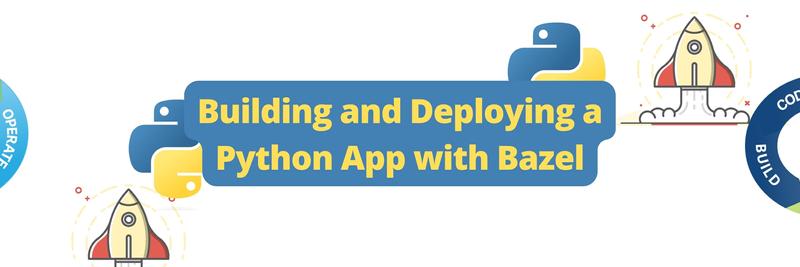Using Bazel to Improve Your Automated Test Suite
In this Series
Table of Contents
This article explores the use of Bazel for testing. Earthly enhances Bazel by offering reproducible and parallel build features. Check it out.
To ensure that your code works as expected even when you ship it to production, you need to integrate automated testing. Automated testing is critical for enterprise-grade software development and delivery. It saves you time and money by rapidly running tests and improves software quality by allowing engineers to run lengthy and time-consuming tests in the background.
If you’re looking to improve your automated test suite, you may want to consider Bazel, an open source software tool used to automate software builds and test software for large projects with multi language dependencies.
In this tutorial, you’ll learn how to use Bazel to improve your automated test suite. You’ll create a Python project and write tests using pytest while using Bazel to run the test suite.
Why Bazel?

When running automated tests to aid the continuous integration, continuous delivery (CI/CD) process, time is critical. The CI/CD pipeline is integral in allowing organizations to iterate quickly and increase production, and large organizations, like Google, Tesla, and Etsy, all incorporate CI/CD practices in their businesses.
Bazel can help speed up the CI/CD process and build and test software quickly and reliably by utilizing several built-in features. One of Bazel’s most notable features is caching. During testing, Bazel only rebuilds what’s required instead of the entire project. Additionally, it caches all previously passed tests. For each test that’s run, the unchanged parts are simply skipped. This helps avoid redundant testing, which saves you time and computing resources. In addition, Bazel uses parallel execution, which allows efficient resource usage and increases throughput by running multiple jobs at the same time. Bazel is both scalable and reliable, making your deployments smoother and faster.
Bazel also allows QA testers to specify a test time-out where tests are automatically aborted or failed when they reach a specified threshold value. This enables software engineers to abort code testing in a timely manner and ensure various nonfunctional requirements are met.
Bazel can work with and build code for a variety of different languages and platforms, including C++, Python, Android, and iOS. Bazel uses designated workspaces and a powerful query language capable of evaluating dependencies.
How to Use Bazel to Improve Your Automated Test Suite
To follow along with the tutorial, you need to have Bazel installed, and you’ll need to have the latest version of Python. You can find the code examples used in this tutorial in this GitHub repo.
Creating a Project
To begin, you need to create a project in Python with automated unit tests using pytest. You can use any language that Bazel supports.
You need to create a project directory and enable a virtual environment:
mkdir bazel-tutorial
cd bazel-tutorial
python -m venv env
source env/bin/activateThen install pytest:
pip install pytestCreate a directory named lib and create an empty __init__.py file in it. Then create the file prime.py inside lib and place the following code in it:
# lib/prime.py
from math import sqrt
def is_prime(n):
flag = True
for i in range(2, int(sqrt(n)) + 1):
if n % i == 0:
flag = False
break
return flagThis file defines a function called is_prime that checks whether a given integer is prime.
Next, you need to create lib/test_prime.py:
# lib/test_prime.py
from lib.prime import is_prime
def test_primes():
primes = [ 3, 5, 17, 31, 43]
for p in primes:
assert is_prime(p) == True
def test_non_primes():
non_primes = [ 4, 10, 56, 48 ]
for p in non_primes:
assert is_prime(p) == False
if __name__ == "__main__":
import pytest
raise SystemExit(pytest.main([__file__]))Here, two unit tests are defined for the is_prime function. Now you can use pytest to run the unit tests and verify that they pass:
$ pytest lib/test_prime.py==================== test session starts ==================
platform linux -- Python 3.10.8, pytest-7.2.1, pluggy-1.0.0
rootdir: /home/aniket/bazeltest
collected 2 items
lib/test_prime.py .. [100%]
======================== 2 passed in 0.00s ================Then create a script that uses the prime library and write tests for that. In the root directory, create main.py and write the following code:
# main.py
from lib.prime import is_prime
def get_all_primes():
primes = []
for i in range(1, 100):
if is_prime(i):
primes.append(i)
return primes
if __name__ == "__main__":
primes = get_all_primes()
for prime in primes:
print(prime)This code uses the is_prime library function to calculate all primes between 1 and 100. Next, create test_main.py in the root directory:
# test_main.py
from main import get_all_primes
def test_main():
expected_primes = [1, 2, 3, 5, 7, 11, 13, 17, 19, 23, 29, \
31, 37, 41, 43, 47, 53, 59, 61, 67, 71, 73, 79, 83, 89, 97]
actual_primes = get_all_primes()
assert expected_primes == actual_primesNow you can run pytest and verify that all the test cases pass:
$ pytest
======================= test session starts =====================
platform linux -- Python 3.10.8, pytest-7.2.1, pluggy-1.0.0
rootdir: /home/aniket/bazeltest
collected 3 items
test_main.py . [ 33%]
lib/test_prime.py .. [100%]
========================== 3 passed in 0.01s =====================Configuring Bazel
To get started with Bazel in a project, you need to declare a workspace. To do so, create a file named WORKSPACE at the root of the project. Usually, an empty WORKSPACE file is enough for Bazel to recognize a workspace, but if you want to, you can have project-specific configurations in this file.
For this particular project, you need to load the Python rules by placing the following code in the WORKSPACE file:
# WORKSPACE
load("@bazel_tools//tools/build_defs/repo:http.bzl", "http_archive")
http_archive(
name = "rules_python",
sha256 = "8c15896f6686beb5c631a4459a3aa8392daccaab805ea899c9d14215074b60ef",
strip_prefix = "rules_python-0.17.3",
url = "https://github.com/bazelbuild/rules_python/archive/refs/tags/0.17.3.tar.gz",
)
load("@rules_python//python:repositories.bzl", "py_repositories")
py_repositories()To tell Bazel how to build, run, or test a particular code, you need to utilize BUILD files. A BUILD file must contain one or more rules that tell Bazel how to build the desired output, which can be an executable, a library, or a test.
Let’s start by creating a BUILD file in the lib directory with the following code:
# lib/BUILD
py_library(
name = "lib_prime",
srcs = ["prime.py"],
visibility = ["//visibility:public"]
)
py_test(
name = "test_prime",
srcs = [ "test_prime.py" ],
deps = [
"//lib:lib_prime"
]
)Here, two rules have been used:
- The
py_libraryrule builds a Python library. Thenameargument is used to provide a name to the target. You can use this name to refer to this particular target from otherBUILDfiles. Thesrcsargument lists the source files, which in this case isprime.py. Thevisibilityargument is used to set the visibility of this target aspublicso that you can use it from the root levelBUILDfile when you write that later. - The
py_testrule builds a unit test fromtest_primes.py. Note that thedepsarray includes thelib_primetarget mentioned previously. This will make sure thelib_primetarget is built before thetest_primetarget is built. It also tells Bazel to rebuildtest_primeiflib_primeis updated, which means that tests will be rerun ifprime.pyis modified.
You can run the tests using the bazel test command from the root of the project like this:
bazel test //lib:test_primeYou should see the following output:
Starting local Bazel server and connecting to it...
INFO: Analyzed target //lib:test_prime (22 packages loaded, \
271 targets configured).
INFO: Found 1 test target...
Target //lib:test_prime up-to-date:
bazel-bin/lib/test_prime
INFO: Elapsed time: 1.760s, Critical Path: 0.25s
INFO: 2 processes: 2 linux-sandbox.
INFO: Build completed successfully, 2 total actions
//lib:test_prime PASSED in 0.2s
Executed 1 out of 1 test: 1 test passes.
INFO: Build completed successfully, 2 total actionsAs you can see, all the tests pass successfully.

Let’s see what happens if there is a failing test. Modify test_prime.py and add a new test case that fails:
# lib/test_prime.py
def test_failing():
assert is_prime(57) == TrueRerun the bazel tes //lib:test_primet command. You should get the following output:
INFO: Analyzed target //lib:test_prime (0 packages loaded, \
0 targets configured).
INFO: Found 1 test target...
FAIL: //lib:test_prime (see /home/aniket/.cache/bazel/_bazel_aniket/ec2610a69f8eaaebf15791a22f7f56d5/execroot/__main__/bazel-out/k8-fastbuild/testlogs/lib/test_prime/test.log)
Target //lib:test_prime up-to-date:
bazel-bin/lib/test_prime
INFO: Elapsed time: 0.305s, Critical Path: 0.25s
INFO: 2 processes: 2 linux-sandbox.
INFO: Build completed, 1 test FAILED, 2 total actions
//lib:test_prime FAILED in 0.2s
/home/aniket/.cache/bazel/_bazel_aniket/ec2610a69f8eaaebf15791a22f7f56d5/execroot/__main__/bazel-out/k8-fastbuild/testlogs/lib/test_prime/test.log
INFO: Build completed, 1 test FAILED, 2 total actionsAs you can see, it shows that the test fails. Bazel also creates a bazel-testlogs directory (among three other directories) where you can find more details about the tests that were run. The log will be stored in bazel-testlogs/<target-name>/test.log. In this case, it’s bazel-testlogs/lib/test_prime/test.log:
$ cat bazel-testlogs/lib/test_prime/test.logexec ${PAGER:-/usr/bin/less} '$0' || exit 1
Executing tests from //lib:test_prime
---------------------------------------------------
================== test session starts =============
platform linux -- Python 3.10.8, pytest-7.2.1, pluggy-1.0.0
rootdir: /home/aniket/.cache/bazel/_bazel_aniket/ec2610a69f8eaaebf15791a22f7f56d5/sandbox/linux-sandbox/3/execroot/__main__/bazel-out/k8-fastbuild/bin/lib/test_prime.runfiles/__main__
collected 3 items
lib/test_prime.py ..F [100%]
================== FAILURES ======================
___________________ test_failing _________________
def test_failing():
> assert is_prime(57) == True
E assert False == True
E + where False = is_prime(57)
lib/test_prime.py:13: AssertionError
================== short test summary info ====================
FAILED lib/test_prime.py::test_failing - assert False == True
================== 1 failed, 2 passed in 0.02s =================Remove the failing test and rerun the bazel test command so that all the tests pass again.
Let’s now tell Bazel to run tests for the main application. Again, in order to tell Bazel what to build and how to build, you need a BUILD file. Create a BUILD file in the root directory and place the following code in it:
# BUILD
py_binary(
name = "main",
srcs = ["main.py"],
deps = [
"//lib:lib_prime"
],
)
py_test(
name = "test_main",
srcs = [ "test_main.py" ],
deps = [
":main"
]
)This BUILD file is similar to the BUILD file of the lib package. The only difference is that this time, py_binary is used instead of py_library. The py_binary rule creates an executable file in the bazel-bin directory when the target is built with the bazel build command.
You can now run all the tests with the following command:
bazel test //...You should see the following output:
INFO: Analyzed 4 targets (0 packages loaded, 0 targets configured).
INFO: Found 2 targets and 2 test targets...
INFO: Elapsed time: 0.128s, Critical Path: 0.07s
INFO: 2 processes: 2 linux-sandbox.
INFO: Build completed successfully, 2 total actions
//lib:test_prime (cached) PASSED in 0.2s
//:test_main PASSED in 0.1s
Executed 1 out of 2 tests: 2 tests pass.
INFO: Build completed successfully, 2 total actionsNote that both test suites were run. In addition, note the output of //lib:test_prime. As you can see, it says “cached.” This is because Bazel caches all passed tests, and since the prime.py file has not changed between the last two runs, there’s no need to run the tests again, so Bazel loads the result from the cache. If you run the command again, you’ll see both tests are now loaded from the cache:
INFO: Analyzed 4 targets (0 packages loaded, 0 targets configured).
INFO: Found 2 targets and 2 test targets...
INFO: Elapsed time: 0.048s, Critical Path: 0.01s
INFO: 1 process: 1 internal.
INFO: Build completed successfully, 1 total action
//:test_main (cached) PASSED in 0.1s
//lib:test_prime (cached) PASSED in 0.2s
Executed 0 out of 2 tests: 2 tests pass.
INFO: Build completed successfully, 1 total actionIn a big project with a large number of automated test cases, Bazel’s caching can save a lot of time since you don’t have to run tests unnecessarily. This improves the development and deployment speed of your project by cutting down the test time by a significant amount.
Bazel is also infinitely customizable because you can create custom rules that can change the testing method however you like. For example, if you want to use nose2 instead of pytest, you can do so by writing a custom rule similar to py_test.
Conclusion
In this article, you learned about Bazel, a fast and reliable tool that supports multiple languages and helps you with automated tests.
Bazel is useful when you’re working with different operating systems utilizing different languages, as you would only have to write the code once. Bazel enables users to create rules for rapid application testing and provides the ability to define custom rules, resulting in increased flexibility.
Another useful tool to speed up automated testing is Earthly. Earthly is a simple framework that enables the creation of pipelines that can be developed locally and executed on any platform. It uses containers to run the pipelines, making them self-sufficient, repeatable, portable, and capable of running in parallel. It helps speed up builds since the cache is retained between builds.
Earthly Lunar: Monitoring for your SDLC
Achieve Engineering Excellence with universal SDLC monitoring that works with every tech stack, microservice, and CI pipeline.





